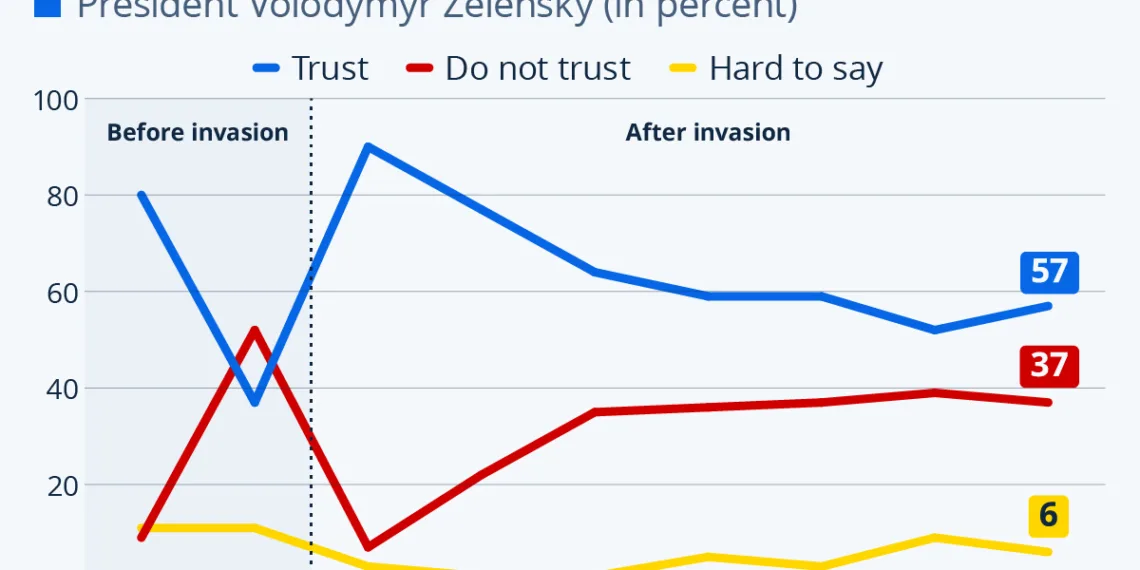Understanding the Dispute Between Trump and Zelensky
In recent weeks, tensions have escalated between U.S. President Donald Trump and Ukrainian President Volodymyr Zelensky. The backdrop of this conflict is the ongoing war in Ukraine, which has led to a complex international landscape. This blog delves into the exchange of claims and counterclaims, focusing on the accuracy of Zelensky’s approval ratings and the political ramifications of the dispute.
Trump’s Claims About Zelensky’s Approval Rating
Donald Trump has publicly stated that Ukrainian President Volodymyr Zelensky holds only a four percent approval rating. This assertion has raised eyebrows, given the tumultuous political environment both leaders are navigating. Trump further went on to label Zelensky a “dictator without elections,” a statement that is not only provocative but also misleading.
Zelensky Responds: A Web of Disinformation
In response to Trump’s claims, Zelensky accused the former U.S. President of being ensnared in a "web of disinformation." This assertion highlights a growing concern regarding misinformation in political discourse, especially against the backdrop of war. Zelensky’s defiance underscores a commitment to transparency and factual representation during a period rife with conflict and distortion.
The Reality of Zelensky’s Approval Ratings
To offset Trump’s erroneous claims, the Kyiv International Institute of Sociology (KIIS) conducted a poll that reflects a more favorable view of Zelensky among the Ukrainian populace. The survey, conducted between February 4-9, reveals that a significant 57 percent of adults trust Zelensky, while 37 percent do not. This statistic starkly contrasts Trump’s assertion, indicating a disconnect between political rhetoric and public sentiment.
Historical Context of Approval Ratings
Zelensky’s approval ratings have indeed fluctuated since Russia’s invasion in February 2022. Back in May 2022, the Ukrainian president enjoyed a remarkable 90 percent trust rating, a figure reflecting the unity and resilience of the Ukrainian people in the face of war. However, as the conflict has persisted, these numbers have naturally declined. Despite this downward trend, recent polling indicates a recovery; Zelensky’s approval rose five percentage points compared to December 2024, suggesting that public sentiment may be stabilizing.
Methodology of the KIIS Poll
The KIIS poll was designed to present a representative sample of individuals from Ukrainian-controlled territories, paying particular attention to the unique challenges posed by wartime conditions. Methodological rigor was applied, taking into account systemic deviations alongside traditional margins of error, thereby enhancing the credibility of the results.
The Politics of Wartime Elections
Zelensky was elected in 2019 with a landslide 73 percent of the vote, reflecting the Ukrainian public’s strong mandate for reform and governance. However, in light of the ongoing conflict with Russia, national elections scheduled for 2024 have been postponed indefinitely. Zelensky has publicly stated that elections will resume once what he terms the “hot phase” of the war comes to an end, showcasing his commitment to democratic processes even amidst turmoil.
Conclusion
The misinformation tactics that often surface in political narratives can have profound implications for public perception and international relations. As the situation evolves, it is critical for both leaders and followers to sift through these claims critically, seeking out factual representation in an era increasingly characterized by disinformation. The conversation between Trump and Zelensky is reflective of broader themes surrounding leadership, trust, and the challenges of governance in a time of crisis.






